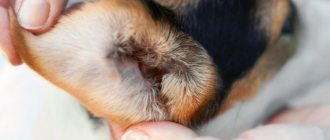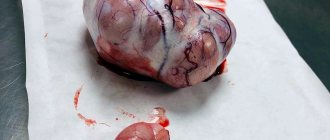Cystitis is an inflammation of the bladder. This is a common urological disease among dogs, a characteristic symptom of which is frequent urge to go to the toilet. How cystitis manifests itself in dogs, how to treat inflammation of the bladder, and whether its development can be prevented - more on this later.
See this article:
Causes of bladder inflammation How does cystitis manifest in dogs? Forms of cystitis Diagnosis How to cure cystitis in a dog? Why is bladder inflammation dangerous? Prevention of cystitis
Causes of bladder inflammation
In 70% of cases, the cause of cystitis in dogs is bacterial infections. The causative agents can be chlamydia, mycoplasma, E. coli, etc. Bacterial infections often develop due to poor hygiene, long-term use of antibiotics and a weak immune system.
Other causes of cystitis in dogs:
- Hypothermia . An autumn walk in the rain, sleeping on a cold floor, swimming in a cool pond - all this can lead to hypothermia and the development of an inflammatory process.
- Complications after genitourinary diseases . Cystitis often develops against the background of urolithiasis (urolithiasis), inflammation of the urethra (urethra), inflammation of the kidneys, etc.
- Invasive diseases . Cystitis often occurs due to parasitic diseases localized in the bladder or other organs of the animal’s genitourinary system (for example, trichomoniasis).
- Mechanical damage to the genitourinary organs, including the bladder. Possible causes include serious injuries, which often occur from impacts, falls from heights, and traffic accidents.
- Intoxication (poisoning). One of the causes of inflammation of the bladder is poisoning of the dog with household chemicals, poisons (for example, chemicals) and medications.
- Metabolic disease. Its common causes include poor nutrition, failure to drink properly, etc. This can lead to the appearance of stones, blockage of the urinary canals and the development of inflammation.
Additional factors that provoke the development of cystitis in animals include frequent stress that negatively affects the condition of the whole body, deficiency of vitamins and microelements, frequent overeating and inflammation of any nature (for example, gastritis). In bitches, bladder inflammation may be associated with gynecological problems (for example, vaginitis).
Hygiene rules for dogs
According to generally accepted rules of keeping, a dog should be bathed no more than 4 times a year. Bathing too often causes the sebaceous glands to become overactive, resulting in an unpleasant odor from the dog. An equally important role is played by diet, with the help of which the functioning of metabolic processes is corrected.
To prevent your dog from becoming infected with the fungus, you must: ensure that it does not come into contact with stray animals and does not walk near places where garbage accumulates. To prevent parasites, every 3-4 months, the dog needs to be given anthelmintic drugs.
Most problems associated with inflammatory processes in the oral cavity and dental diseases can be prevented by observing good dog hygiene. To take care of the teeth, the puppy is taught to use a toothbrush in a playful way. At the first stages, the teeth are not brushed, but only imitates the process. The dog should not perceive the toothbrush as a toy or a threat. After the molars erupt, at the age of 10-11 months, the puppy is taught to brush its teeth with toothpaste.
How does cystitis manifest in dogs?
The first thing you need to pay attention to is that the dog urinates often (4-5 times in 1 hour). There may be a false urge to urinate. If you suspect that your dog has cystitis, then pay attention to how he relieves himself. Males change their position, sitting down when urinating, to avoid pain.
Symptoms of cystitis in dogs:
- urinary incontinence,
- pain when urinating (can be determined by growling, whining of the pet),
- impurities of blood and pus in the urine,
- temperature increase,
- strong unpleasant odor of urine,
- abdominal wall tension,
- lack of appetite,
- strong thirst
- sluggish and apathetic state,
- decreased activity.
Signs of cystitis in dogs appear gradually. At the first stage, it is much more difficult to recognize the problem, because the animal’s urge to go to the toilet only becomes more frequent, but otherwise its condition remains the same. If you suspect that your pet has a bladder infection, do not waste time - contact a veterinary clinic in Moscow.
Diabetes
A strong smell of urine from a dog indicates high blood sugar. To ensure otherwise, you will need to donate blood for sugar and definitely do a general urine test. It is better to take blood tests before and after meals to make the picture clearer.
Signs of diabetes in a dog are primarily frequent urination. The condition of the coat deteriorates, the dog is often thirsty; drying of the oral mucosa, tachycardia, general weakness, clouding of the eyes and lenses; When you feel your stomach, you feel an enlarged liver.
In the early stages, it is possible to detect diabetes through a urine test. A strong ammonia smell is the first sign of diabetes.
Diabetes mellitus is a hereditary disease. It is impossible to completely cure pathology in dogs, as in people. It will only be possible to stop the disease without allowing the condition to worsen. To combat this, special preparations with insulin have been developed. You should not skip taking medications for fear of making you feel worse. The best help in treating the disease is a proper diet. Special foods have been created for dogs suffering from the disorder. It is better to buy food that has proven itself well; nutrition is the key to your pet’s health.
Forms of cystitis
Spicy . Its main feature is the rapid development of all signs of the inflammatory process, including frequent urge to urinate, intense pain, and lack of appetite. An acute form of cystitis requires immediate contact with a veterinary clinic. Delay can lead to serious complications, including the development of purulent cystitis.
Chronic . With this form of bladder inflammation there are no pronounced symptoms. There is no increased body temperature or intense pain. However, the pet requires supportive therapy and special care aimed at preventing exacerbation of cystitis.
How to remove dried traces?
Before removing dried traces of dog urine, it is recommended to carry out preparatory work:
- Using a stiff, dry brush, work the stain to remove the crust.
- Use a vacuum cleaner to collect everything that was crumbled with a brush.
- Place a rag under the carpet and thoroughly wet the contaminated area with a wet sponge (carry out the manipulation several times).
You should prepare for the fact that you won’t be able to remove the disgusting smell and stain the first time. You will have to carry out several cleansing procedures.
Dilute dishwashing detergent in a glass of water until a thick foam forms. Then pour the mixture onto the stain, rub in a little and leave for at least an hour. Afterwards, blot the stain with a cloth or paper towel. It is advisable to press as hard as possible on the carpet so that as much liquid as possible comes out.
To completely remove the liquid, it is recommended to additionally treat the stain with a vacuum cleaner. Repeat the procedure until the stain completely disappears.
REFERENCE! When the stain is already old, it is better to entrust this matter to professionals. A professional dry cleaner offers a service where professionals can come to your home, or you can take the carpet to the laundromat.
Pet stores offer liquid consistencies and special powders that get rid of old stains. Each product is used exclusively according to the instructions, which must not be violated under any circumstances.
Diagnostics
Only a veterinarian can make an accurate diagnosis. He will examine the patient and ask the owner several questions to determine the cause of the disease. This is necessary to prescribe effective treatment.
The specialist will definitely take blood and urine for general and biochemical studies. If necessary, a bacterial test is prescribed to determine the type of infection that provoked the inflammatory process.
Additionally, the veterinarian prescribes:
- Ultrasound examination (ultrasound) of the abdominal area . It is necessary to identify sand or stones in the urinary system, as well as check the condition of other genital organs.
- X-ray examination . It shows not only stones, but also neoplasms, which can also provoke inflammation of the bladder and urinary system.
- Cytoscopy . Examination and examination of the inner surface of the bladder. At the same time, this diagnostic method allows for medical manipulations (for example, administering antiseptic solutions).
Typically, the diagnosis of cystitis in a dog is carried out on the day of visiting a veterinarian in Moscow. This allows you to quickly identify the inflammatory process, detect the cause of its occurrence and prescribe treatment.
How to get rid of unpleasant odors in your apartment and home
After getting rid of your dog odor problems, you may find that some things in your home continue to emit a foul odor. How to get rid of unpleasant odors in your apartment and home?
There are several methods, so the optimal choice will depend on the item that emits the smell. If we are talking about dog bedding, it is better to change it. If you are not ready for this step, the cover must be removed and washed at the highest possible temperature. Afterwards, the cover must be dried in direct sunlight.
Advice: the easiest way to get rid of unpleasant odors from all things made of fabric is to dry clean them.
If the smell comes from upholstered furniture, it is better to use professional products. Practice shows that cleaning products intended for cleaning in medical institutions work most effectively. Before treating upholstered furniture, test the effect of the product on the color and condition of the fabric.
Carpets and floor coverings are treated with detergents. It should be noted that the use of bleach in these cases is practically useless. As a result, your carpet or other covering will smell of both dog and bleach.
How to cure cystitis in a dog?
Treatment of cystitis allows you to eliminate the cause of inflammation (for example, a bacterial infection), restore urinary function and relieve pain in your dog. The course of treatment for the acute form of the disease is 7-10 days, for the chronic form – 14-21 days.
It is based on drug therapy. It includes the following:
- Antibiotics . They are designed to eliminate pathogenic microflora that provoke inflammation of the bladder.
- Analgesics . They are prescribed for intense pain syndrome, characteristic of the acute form of cystitis.
- Drugs that stop bleeding. They are used if blood clots are found in the pet’s urine.
- Antispasmodics. They are designed to facilitate the process of urination and are used for all forms of cystitis.
- Anti-inflammatory drugs. Provide suppression of the inflammatory process and decrease in body temperature.
- Diuretics. They increase urine volume and accelerate the process of eliminating inflammatory microorganisms.
Do not self-medicate. Only a veterinarian who has examined the pet and received the results of laboratory tests (tests) can prescribe medications for the treatment of cystitis in a dog.
What to do if your pet just peed on the floor?
It is better for the owner to constantly monitor the dog’s behavior in order to be able to eliminate traces of his tricks in a timely manner. If the urine stain is fresh, the first step is to soak it with a paper or cloth towel (even an ordinary thick napkin will do). Next you need to start dry cleaning the carpet.
Important! To do this, soda and starch are mixed in equal proportions and applied to the resulting stain. Leave the mixture until the unpleasant odor and liquid are completely eliminated. You need to remove the remaining mixture with a vacuum cleaner (usually you will have to vacuum several times to do this).
The following special products also combat fresh stains:
- Vanish;
- Mister proper;
- Mister Muscle.
They are easy to use: dilute according to the instructions and apply to the required area. The stain is wiped with a soft brush or sponge and then rinsed with clean water.
If the material is not afraid of chlorine, then you can use chlorine-containing products, for example, whiteness or Domestos. It is enough to add 50-70 ml of product to a bucket of water. To avoid the pungent smell of the cleaning product, you can add a few drops of aroma oil to the water. Don't forget to ventilate the room.
You will find 6 traditional recipes for dry cleaning a carpet at home in this article, and 10 reliable methods for removing odors from a carpet at home in this article.
Why is bladder inflammation dangerous?
The main feature of cystitis in dogs is its rapid development. Inflammation quickly spreads throughout the organs of the urinary system, covering not only the bladder, but also the urethra, ureters, kidneys, etc.
If you do not pay attention to the fact that your dog often pees and do not consult a doctor in a timely manner, complications are possible:
- Urolithiasis (UCD) . Due to the lack of proper treatment, urine with cystitis begins to crystallize and becomes alkaline. Stones and sand that form in the bladder interfere with the drainage of fluid and can be fatal.
- Pyelonephritis . Severe inflammation of the kidneys, accompanied by fever and increased blood pressure. It can be unilateral or bilateral, with the latter form being difficult to treat.
- Other consequences . For example, urinary incontinence in dogs (involuntary urination), chronic renal failure, etc.
Should a healthy dog smell?
An attentive owner can guess that a pet is not healthy by the slightest, primary signs. However, if you have no experience in keeping dogs, even basic questions can become difficult. Should a healthy dog smell?
Regardless of the type of fur, age and breed of a healthy dog, it has an odor. The question is its intensity. Moreover, the smell does not always come from wool; we will go into more detail below. The dog owner who lives in the same living space usually does not notice any foreign odor. If you start to notice that your dog smells, it most likely has health problems.
Prevention of cystitis
To prevent the development of the inflammatory process, try to prevent hypothermia of the animal’s body. For example, during autumn walks, small breed dogs need to be warmed with special clothing.
Useful tips for preventing cystitis:
- Do not neglect deworming to protect your dog from parasitic diseases and cystitis that develops against them.
- Vaccinate every year so that your dog develops immunity to infections that can cause inflammation.
- Provide proper and balanced nutrition for the animal using ready-made food or a natural diet.
- If your pet has already suffered from cystitis, then do not forget about regular preventive examinations at the veterinarian.
- If infections of the lower urinary tract develop, contact a specialist in a timely manner to prevent complications.
Cystitis in dogs is a common but dangerous disease. If you suspect that your pet has an inflamed bladder, then do not hesitate - make an appointment at the veterinary clinic and get examined.
Sources of unpleasant odor from dogs and their prevention
There is a not entirely clear term “dog smell”. It is this smell that most owners who are just thinking about getting a dog are afraid of. If you are sure that it is not fur that smells, it is important to determine the sources of your dog’s unpleasant odor and how to prevent them.
Dog smell from fur and skin
The dog smell from fur and skin is a consequence of a defense mechanism. A dog's skin is much more delicate than a human's. The skin glands constantly secrete oils and enzymes to protect the skin from the harmful effects of water. The layer of fat that is constantly present on the skin of a healthy dog is called lipid.
When the fur gets wet, the water reacts with the sebum, resulting in an unpleasant odor from the dog. Normally, the smell should go away as soon as the dog's fur dries. If the dog gets wet in the winter when it has an undercoat, it is important to make sure the coat is completely dry, otherwise the smell will not go away.
Important! Wet undercoat can cause the development of dermatitis, which becomes apparent at the stage of serious skin inflammation.
Unpleasant odor from the mouth
An unpleasant odor from the mouth is always a symptom. The exception is when the dog picks up leftover food from the ground. The appearance of an unpleasant odor from the mouth may be accompanied by:
- Rotting teeth.
- Inflammatory processes of the gums.
- Rotting food that gets stuck between the teeth or under the hoods of the gums.
- Chronic problems with the gastrointestinal tract.
- Tartar.











